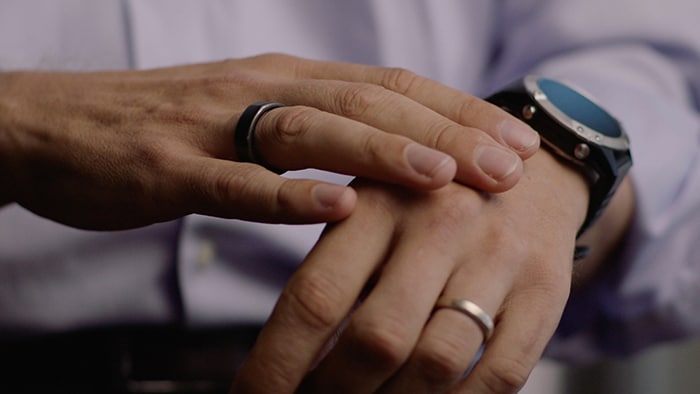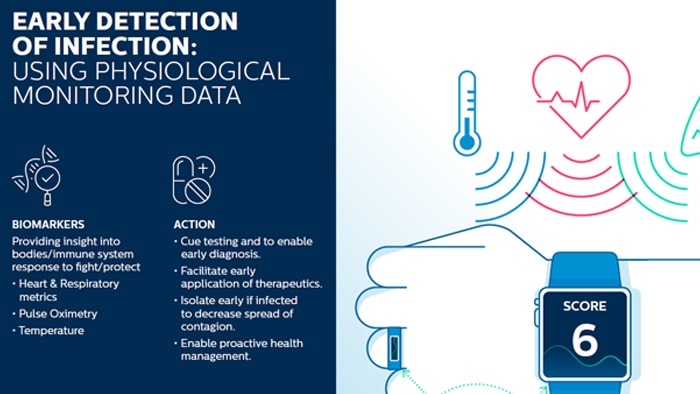Sep 22, 2020
The U.S. Department of Defense, Philips Expand Research on Groundbreaking AI Technology, Opening New Front in Battle to Contain COVID-19
Using clinical trials in both military and non-military personnel, researchers try to identify pre- symptomatic and asymptomatic individuals using wearables that track vitals biomarkers
(Cambridge, MA, Mountain View, CA and Washington, D.C. – September 22, 2020) The U.S. Defense Threat Reduction Agency (DTRA), Defense Innovation Unit (DIU), and Philips today announced expansion of the research project around their artificial intelligence-based early warning system for infectious disease. The new system prototype will be an application of the Rapid Analysis of Threat Exposure (RATE) technology and part of the DoD’s rapid response to the COVID-19 outbreak to contain its spread. The accelerated research includes COVID-19 detection among a dozen different cohorts in clinical trials, using wearable technologies such as watches and rings that can capture vital sign and biomarker information. In the wake of the COVID-19 pandemic, the RATE project’s goal of facilitating faster diagnosis and treatment of infection and containing spread has never been more important. Through the RATE, researchers discovered that exposure to infectious agents causes subtle changes in people’s physiology before they experience symptoms. Identifying these changes early in the infection is critical to containing the spread, as asymptomatic and pre-symptomatic individuals don’t yet show signs of infection, and can unwittingly spread the disease to others. An early warning solution could potentially alert people of their possible infection, and enable them to quarantine and change their behaviors sooner to avoid infecting others.
RATE would allow us to non-invasively monitor a service member’s health and provide early alerts to potential infection that will help us to ensure troop readiness, better support their health and protect against the threat of further spread of the disease.
Edward Argenta
Science and Technology Manager at DTRA
“RATE would allow us to non-invasively monitor a service member’s health and provide early alerts to potential infection that will help us to ensure troop readiness, better support their health and protect against the threat of further spread of the disease,” said Edward Argenta, Science and Technology Manager at DTRA. “Unlike other more narrow approaches, this solution is designed to recognize a wide variety of infections and can help identify future novel threats.” The COVID-19 pandemic is having a profound impact on society, the economy and the country. It has become a catalyst for healthcare transformation, requiring organizations to be more adaptive to drive rapid innovation. RATE is an example of public-private partnership, pivoting to quickly address the challenge. RATE integrates with consumer commercial-off-the-shelf (COTS) wearables to measure biomarkers. The biomarker data is processed in the cloud as part of a Software as a Service (SaaS) model and allows users to see their hourly RATE score through a secure web site. The RATE-COVID system began deployment with U.S. military units on June 16, 2020, and the study is expected to grow to several thousand participants in the next few weeks. “By combining commercial technology, a rich data source and simple to use wearables, we are effectively providing a check-engine light on the military service member and getting that alert before they’re broken down with a disease. In military speak, we’re targeting left-of-cough awareness,” said Christian Whitchurch, PhD, DIU Human Systems Portfolio Director. The RATE-COVID is designed to eventually work with any/all wearables, and will be able to deploy in a bring-your-own-device (BYOD) approach in the future, Because of its broad foundation on empirical science, the RATE approach uses large-scale data machine learning and trade-space analyses across 165 different biomarkers from a rich Philips data set of over 41,000 cases of hospital acquired infection. The risk score works for multiple general types of infection, including COVID-19. Philips scientists are looking at ways the solution can be used to detect the next new unknown infectious agent. The technology could further be applied in a civilian capacity by helping to monitor hospital patients for infection prior to clinical symptoms. Moreover, the early warning solution could help organizations to manage COVID-19 return-to-work activities by helping with the early identification of individuals who may be infected and who should self-isolate and work from home. “The RATE science shows that physiological response to infection has similarities across different types of infectious agents, and we anticipate that this will also apply to RATE-COVID, giving us a useful early warning solution,” said Dr. Joe Frassica, Chief Medical Officer and Head of Philips Research North America. “As we continue to get new data from monitored cases of COVID-19, we will be able to refine the RATE-COVID algorithm in the near future. We hope that this will not only allow us to protect people from contracting the disease, but to also intervene early and treat those who are infected.” The Defense Advanced Research Projects Agency also provided funding for the RATE-COVID effort and provided expertise in networking issues for DoD use. This project was also in collaboration with Texas A&M Engineering Experiment Station.
About Defense Innovation Unit
The Defense Innovation Unit (DIU) accelerates the adoption of commercial technology throughout the military and growing the national security innovation base. DIU partners with organizations across the Department of Defense (DoD), to rapidly prototype, field and scale advanced commercial solutions that address national security challenges. Learn more at www.diu.mil.
Media Contact: media@diu.mil
About Defense Threat Reduction Agency
The Defense Threat Reduction Agency enables DoD, the U.S. Government and International Partners to counter and deter Weapons of Mass Destruction and Improvised Threat Networks. DTRA is a Combat Support Agency and a Defense Agency with a three-pronged mission (1) to counter the threats posed by the full spectrum of weapons of mass destruction (WMD), including chemical, biological, radiological, nuclear, and high-yield explosives; (2) to counter the threats posed by the growing, evolving categories of improvised threats, including improvised explosive devices, car bombs and weaponized consumer drones, as well as the tactics, technologies and networks that put them on the battlefield; (3) to ensure the U.S. military maintains a safe, secure, effective and credible nuclear weapons deterrent. Media Contact: dtra.belvoir.org.list.public-affairs@mail.mil
Topics
Contacts

Silvie Casanova
Philips North America Tel: +1 781-879-0692
You are now exiting the Philips United States (US) site and entering the Philips global site. This content is intended for a global audience. It may not apply to the US and should not be interpreted as meeting US standards, executive orders or regulations.
Continue
Avi Dines
Philips North America Tel: +1 781-690-3814
You are now exiting the Philips United States (US) site and entering the Philips global site. This content is intended for a global audience. It may not apply to the US and should not be interpreted as meeting US standards, executive orders or regulations.
Continue










